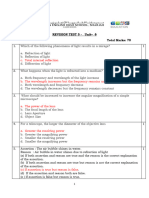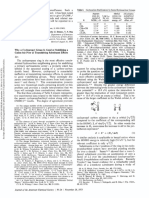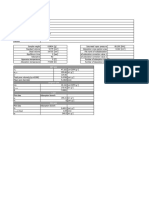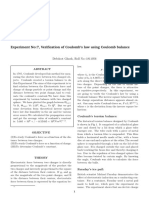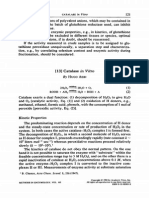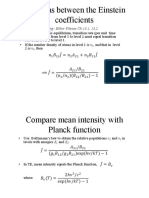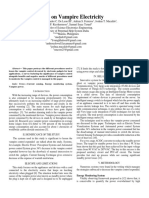Name: Roll no:
Std: Date:
(A) Both A and R are true and R is the correct explanation of A.
(B) Both A and R are true but R is NOT the correct explanation of A.
(C) A is true but R is false.
(D) A is false and R is true.
1. Assertion: Plane mirror may form real image.
Reason: Plane mirror forms virtual image, if object is real.
2. Assertion (A): The focal length of the convex mirror will increase, if the mirror is placed in
water.
𝑅
Reason (R): The focal length of a convex mirror of radius R is equal to, f = 2
3. Assertion (A): The image formed by a concave mirror is certainly real if the object is
virtual.
Reason (R): The image formed by a concave mirror is certainly virtual if the object is real.
4. Assertion (A): An object is placed at a distance of ‘f’ from a convex mirror of focal length
f, its image will form at infinity.
Reason (R): The distance of image in convex mirror can never be infinity.
5. Assertion (A): If the rays are diverging after emerging from a lens; the lens must be
concave.
Reason (R): The convex lens can give diverging rays.
6. Assertion (A): Refractive index of glass with respect to air is different for red light and
violet light.
Reason (R): Refractive index of a pair of media depends on the wavelength of light used.
7. Assertion (A): The refractive index of diamond is √6 and refractive index of a liquid is√3 .
If the light travels from diamond to the liquid, it will be initially reflected when the angle of
incidence is 30°.
Reason (R): where μ is the refractive index of diamond with respect to liquid.
8. Assertion: Light travels faster in glass than in air.
Reason: Glass is denser than air.
9. Assertion (A): Eye lens has the ability to focus clearly on the retina by adjusting its focal
length.
Reason (R): This phenomenon is known as power of accommodation.
�10. Assertion (A): A hypermetropic person prefers to remove his spectacles, while driving.
Reason (R): When a hypermetropic person wearing the spectacles looks at a distant object,
the parallel rays from the distant object get converged in front of the retina. The image thus
appears blurred.
11. Assertion (A): Concave lens is used to correct myopia or short-sightedness.
Reason (R): A concave lens of suitable focal length diverges the parallel rays from the distant
objects as if they are coming from the far point of the myopic eye. This helps the eye lens to
form a clear image at the retina.
12. Assertion (A): Light from a distant object arriving at the eye lens may get converged at a
point in front of the retina.
Reason (R): The eye is producing too much divergence in the incident beam.
13. Assertion (A): A white light on passing through prism splits into its component colours as
such that the red light emerges nearest to the base of the prism.
Reason (R): Wavelength of red light is more than other component colours and hence, red
light deviates least.
14. Assertion (A): Sunlight reaches us without dispersion in the form of white light and not as
its components.
Reason (R): Dispersion takes place due to variation of refractive index for different
wavelength but in vacuum the speed of light is independent of wavelength and hence vacuum
is a non-dispersive medium.
15. Assertion (A): In case of rainbow, light at the inner surface of the water drop gets
internally reflected.
Reason (R): The angle between the refracted ray and normal to the drop surface is greater
than the critical angle.
16. Assertion (A): Scattering of light is the reflection of light from an object in all directions.
Reason (R): The colour of scattered light depends on the size of scattering particles and
wavelength of light.



